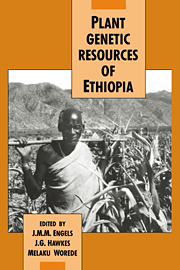Book contents
- Frontmatter
- Contents
- Contributors
- List of acronyms
- Preface
- Part I General introduction
- Part II The Ethiopian centre of diversity
- 2 The Ethiopian gene centre and its genetic diversity
- 3 Crops with wild relatives found in Ethiopia
- 4 Diversity of the Ethiopian flora
- 5 Forest genetic resources of Ethiopia
- 6 Plants as a primary source of drugs in the traditional health practices of Ethiopia
- 7 Traditional aromatic and perfume plants in central Ethiopia (a botanical and ethno-historical survey)
- 8 Spice germplasm in Ethiopia
- 9 A diversity study in Ethiopian barley
- 10 Sorghum history in relation to Ethiopia
- 11 Prehistoric Ethiopia and India: contacts through sorghum and millet genetic resources
- 12 Konso agriculture and its plant genetic resources
- Part III Germplasm collection and conservation in Ethiopia
- Part IV Evaluation and utilization of Ethiopian genetic resources
- Index
4 - Diversity of the Ethiopian flora
Published online by Cambridge University Press: 30 October 2009
- Frontmatter
- Contents
- Contributors
- List of acronyms
- Preface
- Part I General introduction
- Part II The Ethiopian centre of diversity
- 2 The Ethiopian gene centre and its genetic diversity
- 3 Crops with wild relatives found in Ethiopia
- 4 Diversity of the Ethiopian flora
- 5 Forest genetic resources of Ethiopia
- 6 Plants as a primary source of drugs in the traditional health practices of Ethiopia
- 7 Traditional aromatic and perfume plants in central Ethiopia (a botanical and ethno-historical survey)
- 8 Spice germplasm in Ethiopia
- 9 A diversity study in Ethiopian barley
- 10 Sorghum history in relation to Ethiopia
- 11 Prehistoric Ethiopia and India: contacts through sorghum and millet genetic resources
- 12 Konso agriculture and its plant genetic resources
- Part III Germplasm collection and conservation in Ethiopia
- Part IV Evaluation and utilization of Ethiopian genetic resources
- Index
Summary
Introduction
It is generally accepted that Ethiopia is an important domestication and genetic diversification centre of crop species (Purseglove, 1968; Mooney, 1979). Likewise, it is instinctively felt that it must have a rich flora. But this is not known quantitatively, partly because efforts at documenting Ethiopian plants have been sporadic (Friis, 1982) and as a result, many plants remain unrecorded. On the other hand, hasty recording has often meant that a species goes by different names, causing double counting. The situation is made more confusing because the plant specimens collected from Ethiopia are scattered in various herbaria, mostly in Europe. The information published on them is equally scattered and in numerous European languages (Cufodontis, 1953–72). Compiling information on Ethiopian plants is thus a daunting task.
The Ethiopian Flora Project, supported financially by both the Ethiopian Government and the Swedish Agency for Research Cooperation with Developing Countries (SAREC), was launched to meet this challenge. The project is therefore building a reference herbarium and library so that, in some years’ time, information on Ethiopian plants will be found organized at one reference point in Ethiopia. The project is training young Ethiopian taxonomic botanists so that this information can be continually augmented, managed and updated. It is also writing a Flora of Ethiopia, covering the whole country, so that plant identification, both in the field and in the herbarium, becomes possible.
- Type
- Chapter
- Information
- Plant Genetic Resources of Ethiopia , pp. 75 - 81Publisher: Cambridge University PressPrint publication year: 1991
- 10
- Cited by

